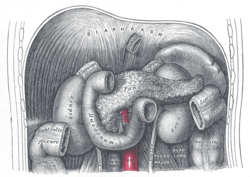Loading AI tools
Two abrupt bends in the large intestine From Wikipedia, the free encyclopedia
In the anatomy of the human digestive tract, there are two colic flexures, or curvatures in the transverse colon. The right colic flexure is also known as the hepatic flexure, and the left colic flexure is also known as the splenic flexure.[1] Note that "right" refers to the patient's anatomical right, which may be depicted on the left of a diagram.
| Colic flexures | |
|---|---|
 The hepatic and splenic flexures labelled at either side of transverse colon | |
 | |
| Details | |
| Precursor | Hindgut |
| Artery | Right colic artery (right flexure), and left colic artery (left flexure) |
| Identifiers | |
| Latin | flexura coli |
| FMA | 14555 |
| Anatomical terminology | |
The right colic flexure or hepatic flexure (as it is next to the liver) is the sharp bend between the ascending colon and the transverse colon. The hepatic flexure lies in the right upper quadrant of the human abdomen. It receives blood supply from the superior mesenteric artery.
The left colic flexure or splenic flexure (as it is close to the spleen) is the sharp bend between the transverse colon and the descending colon. The splenic flexure receives dual blood supply from the terminal branches of the superior mesenteric artery and the inferior mesenteric artery.[2]
The splenic flexure is the last and highest positioned flexure in the colon. Gas can build up at this flexure and give abdominal pain giving rise to a condition known as splenic flexure syndrome. Splenic flexure syndrome is often found in those with irritable bowel syndrome (IBS), and is considered by some practitioners to be a type of IBS since it can also result from stress.[3]
The splenic flexure is a watershed region as it receives dual blood supply from the terminal branches of the superior mesenteric artery and the inferior mesenteric artery, thus making it prone to ischemic damage in cases of low blood pressure because it does not have its own primary source of blood. In the context of bowel ischemia in particular ischemic colitis, the splenic flexure is sometimes referred to as Griffith's point, along with the upper rectum (Sudeck's point).[4][2]
Seamless Wikipedia browsing. On steroids.
Every time you click a link to Wikipedia, Wiktionary or Wikiquote in your browser's search results, it will show the modern Wikiwand interface.
Wikiwand extension is a five stars, simple, with minimum permission required to keep your browsing private, safe and transparent.